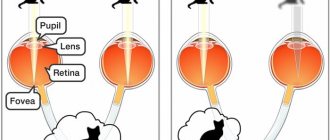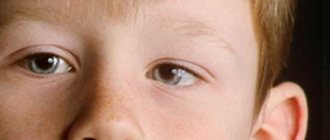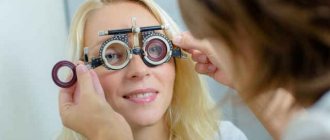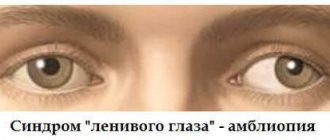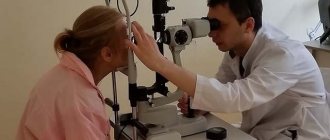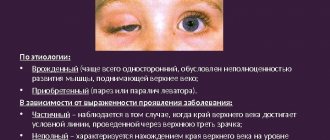Throughout life, a person can develop various eye pathologies. Ocular dysfunction often appears in childhood. For example, amblyopia in children occurs in 2% of cases. Lazy eye syndrome occurs in 4 or even 5% of preschoolers. This disease has its own characteristics and consequences.
Therefore, you need to understand what complications treatment of amblyopia at home can entail. After all, the treatment of lazy eye in children consists of a whole range of procedures.
Risk factors
Some pathological conditions and unfavorable factors can lead to the development of functional disorders of the visual analyzer:
- ametropia - deviation of the refractive power of the eye from age-related values;
- strabismus;
- cerebral palsy;
- mental development disorder;
- III and IV degree of prematurity of the child;
- underweight newborn;
- the presence of ophthalmological diseases in close relatives (amblyopia, strabismus, lens opacity).
The presence of bad habits in pregnant women (smoking and drinking alcohol) increases the risk of developing visual system dysfunction several times.
Forecast
Children who are treated before age 5 usually recover almost completely. In some cases, patients may continue to have problems with depth perception. If the problem is not treated promptly, amblyopia leads to permanent eye damage or muscle problems that may require various surgical procedures.
If the condition is diagnosed and treated at an early age (ideally around 2 years), the outlook for children with lazy eye is good. During the first 6-9 years of life, the visual system develops very quickly.
During this period of growth, complex connections between the eye and brain are created. Amblyopia is more difficult to treat once development is complete, but intervention can be made to improve vision in the weakest eye.
Amblyopia cannot be prevented, but intervention can and should be made at an early stage to prevent it from worsening or becoming chronic. The only appropriate system is early examination and, in the case of therapy, the development of fairly close monitoring programs.
Symptomatic signs
Signs of amblyopia cannot always be detected in a timely manner, since with a mild degree of the disease there is no clinical picture, and only a qualified specialist can suspect the presence of disorders.
Symptoms of amblyopia appear as follows:
- decreased vision in one or both eyes that cannot be corrected with glasses;
- visual perception of objects and their spatial characteristics (size, location of objects relative to each other) is disrupted;
- the symptoms of strabismus (if present) intensify, that is, the asymmetrical arrangement of the corneas relative to the inner corners and outer edges of the eyelid becomes more noticeable;
- The child does not absorb visual information well.
Amblyopia is a childhood disease. The mechanism of development of amblyopia
Our vision is formed after birth. The visual ability of a newly born child is limited to light perception. During the first month of life, visual acuity increases quite quickly, then the growth gradually slows down. By the age of one year, a child’s visual acuity reaches 1/3-1/2 of the adult norm, and one hundred percent vision is achieved only at the age of 3-5 years.
In order for vision to develop, it is necessary that the eye participate in the visual process. But if there are some problems in one of the eyes, the participation of the eyes in the visual process will be different. In the presence of a normally functioning second eye, the difference between the signals coming from both eyes can be so great that the brain will not be able to form a high-quality stereoscopic image, and in order to avoid severe double vision, it will reduce the significance of the signal from the problem eye. Therefore, it is so important to check the vision of young children and eliminate any detected pathologies in a timely manner. Most often, amblyopia is detected during examination of children 3-7 years old. At this age, the likelihood of restoration of vision function is quite high. To do this, you need to eliminate the cause that caused the problem and start training your eye. The popular name for amblyopia is “lazy eye.” In childhood, this “laziness” can still be overcome. If the period of development of visual ability is over, then restoration of the participation of the eye in the visual process is unlikely.
Classification of the disease
Amblyopia can be congenital (primary) or acquired (secondary). Depending on the causes of the development of pathological processes, the following types of disorders are distinguished:
- The refractive form occurs when there is a dysfunction of the accommodative apparatus, unclear focusing of objects with one eye - then this amblyopia is called anisometropic, or with both eyes, in the absence of optical correction. Refractive errors include pathologies such as myopia or farsightedness, refractive errors due to deformation of the shape of the lens, cornea or eyeball.
- Dysbinocular – occurs against the background of strabismus (the visual cortex of the brain perceives information from only one eye to suppress double vision).
- Hysterical (psychogenic blindness) - a sharp decrease in vision occurs against the background of a mental disorder.
- Obscuration amblyopia occurs in children when the optical media of the eye become clouded. Subsequently, eliminating the clouding does not bring a positive result - visual acuity is sharply reduced, despite the absence of structural defects in the posterior segment of the eye. The cause of the obscuration form, the most difficult to treat, is congenital cataract, opacification of the vitreous body and cornea.
- The neurogenic form occurs as a result of inflammation of the optic nerve. A persistent decrease in visual acuity persists even after complete cure of inflammatory processes.
- Maculopathic - vision deteriorates as a result of diseases of the macula, located in the central region of the retina.
- istagmic - a decrease in the acuity of visual function occurs with uncontrolled oscillatory movements of the eyeball.
- Combined amblyopia occurs in the presence of several different functional disorders of the visual analyzer.
Causes of amblyopia
The reasons for the violation may be:
- Strabismus.
- Cataracts, clouding of the cornea or lens, eyelid ptosis.
- Anisometropia.
- Heredity.
- Injuries.
- Exposure to toxins.
Amblyopia of the eye in children can be both the cause of strabismus and its consequence. In the first case, it manifests itself when binocular vision is impaired due to uncoordinated eye movements. In the second, due to the imperfection of the image transmitted to the visual area of the brain. As a rule, it is the squinting eye that becomes “lazy”.
Physiological pathologies of the visual organs interfere with the formation of a clear image on the retina. The distorted image cannot be adequately processed by the brain: as a result, the work of the affected eye is suppressed.
Amblyopia is caused by disturbances in refraction - the refractive power of the optical system, expressed in diopters. Deterioration of vision due to astigmatism, myopia or farsightedness can also cause lazy eye syndrome.
A history of amblyopia in adult relatives can affect the onset of the disease in a child.
Risk factors for amblyopia in a child include conditions such as prematurity, cerebral palsy, low birth weight of the newborn, retinopathy, and mental retardation.
Visual impairment
Stages of severity of pathological processes
Amblyopia manifests itself from a slight decrease in visual function to a sharp deterioration in the visibility of objects. In the first stage of the disease, it is almost impossible to timely detect visual impairment in a child. A weak degree of amblyopia (visual acuity 0.4-0.8) is diagnosed during preventive examinations by an ophthalmologist.
The average degree (visual acuity 0.2-0.3) of impairment may also have no clinical signs and is detected during an ophthalmological examination.
With a high degree of amblyopia, the child’s vision deteriorates (visual acuity 0.1-00.5), visual perception of information decreases.
The highest degree of impairment (from 0.04 and below) is manifested by a sharp decrease in vision; the child cannot see objects.
Prevention
To maintain healthy vision, a routine visit to the ophthalmologist is necessary. If you experience any problems with your eyes, you should go to the hospital immediately.
The child should not be taught to watch TV or the computer uncontrollably; he must adhere to a rest regime and maintain proper nutrition. Parents need to ensure that there is good lighting while reading so that the baby keeps the text at a sufficient distance from the eyes.
High amblyopia in children increases the risk of blindness because there is a high risk of vision loss in the healthy eye. It is necessary to take therapeutic measures while good visual acuity is maintained.
Author: Oksana Belokur, doctor, especially for Okulist.pro
Visometry
The procedure is carried out to determine the visual acuity of a child using special tables that depict pictures or letters, depending on the age of the baby. At a distance of 5 meters from the table, the patient closes one eye, after which he names the picture or letter that the doctor points to. The test is carried out for each eye under certain room lighting.
The results may be influenced by some factors that are taken into account by the specialist - the baby finds himself in an unfamiliar environment, so he can easily get scared and give incorrect answers. To prevent this situation, it is important to create a trusting relationship between the child and the doctor. It is also necessary to make sure that the patient knows the letters and pictures present on the table.
If a young child cannot name pictures, amblyopia may be suspected if there is a negative reaction to occlusion (gluing) in the better-seeing eye.
Identification of visual impairment at the initial consultation requires a repeat procedure. Subsequent examination begins with the visually impaired eye.
Amblyopia in children treatment
Various techniques are used to cure patients. Much depends on the stage, the presence of concomitant or primary pathologies.
Optical vision correction
This means wearing licks and glasses. They reduce the severity of distortions in the perception of objects. Visual acuity itself may remain at the same level. But the objects will not be so distorted. This has a beneficial effect and stops the development of the disease.
Occlusion
An effective treatment method. It is traditionally recommended and has been used for many years. This technique involves closing the eye. That is, the child wears a special device that prevents one or the other eye from seeing. This device can be used to close a healthy or diseased eye.
Often, the eyes alternate. This alternation gives the optimal effect. This method helps cure the disease in the early stages. However, children experience psychological difficulties that must be overcome to recover.
Pleoptics
Represents stimulation of the retina or other affected areas. The technique consists of irritation by influencing the desired area of the eye. Such irritation has a directional effect. It affects the functions of the eye, normalizing them.
Penalization
Based on the involvement of the diseased eye. After all, it doesn't actually work. Therefore, such an eye loses its functions and vision decreases. It is necessary to stimulate his work. Various methods are used for stimulation.
For example, atropine is often instilled, which reduces the functions of a healthy eye. That is, they level out, since both begin to see poorly. It is the equalization of the capabilities of both eyes that gives a stimulating effect and promotes recovery.
Binocular optometric complex
It is a modern equipment for the treatment of amblyopia. This complex identifies the cause of eye dysfunction. At the same time, he accurately determines the cause and acts on it. Therefore, targeted action allows you to cure the disease even with loss of vision.
Hardware treatment
It affects the muscles of the eye. Stimulation of muscles leads to their strengthening, promotes synchronization of eye movements, and eliminates all manifestations of amblyopia. Moreover, the use of the device for treatment is completely safe. Therefore, the hardware method is an excellent option, since different devices are used:
- Color rhythm
- Flipper
- Cascade
- Amblio-1
Return to contents
Surgical intervention
Doesn't practice. The fact is that there is no object for carrying out the operation. The changes are extensive and affect several eye organs.
Exercises
They help restore synchrony of movements. For example, it is recommended to try to focus your vision on an object. A good exercise is to make circular movements. In this case, you need to try to bring your eye as close as possible to the edge of the visual area. This strengthens the muscles and has overall beneficial effects.
Home techniques
Not used. In such conditions, you can only carry out exercises. However, there are no traditional medicines that are effective in treating amblyopathy.
Features of therapy in the presence of strabismus
It is strobism that causes the development of amblyopia. Treatment occurs by increasing the load on the squinting eye. Amblyopia is also cured at the same time. In addition, the listed exercises will also be useful.
Determination of the angle of strabismus
When amblyopia develops against the background of strabismus, the doctor determines the angle of strabismus according to Hirschberg. To do this, the child is asked to look at the ophthalmoscope, after which the doctor records the light reflections. Normally, the glare is projected in the middle of the pupil, but with strabismus - at the edge of the pupil, within or beyond it, which determines the angle of deviation.
Determining the nature of visual fixation is the most important diagnostic procedure for any form of amblyopia, since the treatment regimen depends on visual fixation.
Get a complete vision examination at the Lege Artis Eye Clinic
It's time to correct your vision!
Make an appointment by phone:
8(804) 333-02-14 Free call
Diagnostics
Determining amblyopia at home is problematic, especially in an infant. To make a diagnosis, the doctor performs the following types of examination:
- visometry – assessment of visual acuity;
- refractometry - study of refraction;
- tests to determine the functioning of the oculomotor system;
- ophthalmoscopy – assessment of pupil fixation, examination of the fundus.
To exclude organic diseases, an ultrasound of the eyes, CT or MRI is performed.
